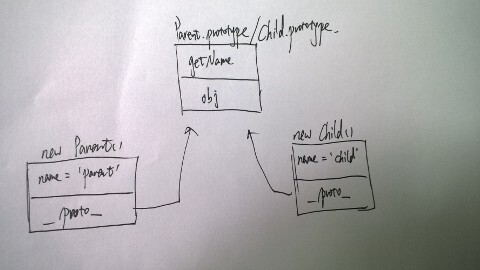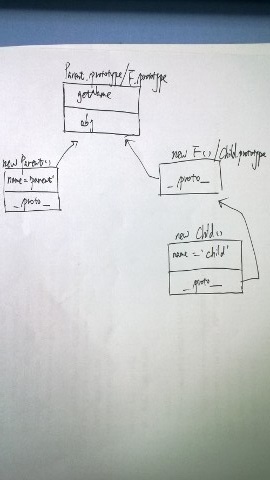再谈javascript原型继承(2)
这样我们就只需要在子类构造函数中执行一次父类的构造函数,同时又可以继承父类原型中的属性,这也比较符合原型的初衷,就是把需要复用的内容放在原型中,我们也只是继承了原型中可复用的内容。上面这种方式的原型图如下:

临时构造函数模式(圣杯模式)
上面借用构造函数模式最后改进的版本还是存在问题,它把父类的原型直接赋值给子类的原型,这就会造成一个问题,就是如果对子类的原型做了修改,那么这个修改同时也会影响到父类的原型,进而影响父类对象,这个肯定不是大家所希望看到的。为了解决这个问题就有了临时构造函数模式。
var Parent = function(name){
this.name = name || 'parent' ;
} ;
Parent.prototype.getName = function(){
return this.name ;
} ;
Parent.prototype.obj = {a : 1} ;
var Child = function(name){
Parent.apply(this,arguments) ;
} ;
var F = new Function(){} ;
F.prototype = Parent.prototype ;
Child.prototype = new F() ;
var parent = new Parent('myParent') ;
var child = new Child('myChild') ;
console.log(parent.getName()) ; //myParent
console.log(child.getName()) ; //myChild
该方法的原型继承图如下:

很容易可以看出,通过在父类原型和子类原型之间加入一个临时的构造函数F,切断了子类原型和父类原型之间的联系,这样当子类原型做修改时就不会影响到父类原型。
我的方法
《Javascript模式》中到圣杯模式就结束了,可是不管上面哪一种方法都有一个不容易被发现的问题。大家可以看到我在'Parent'的prototype属性中加入了一个obj对象字面量属性,但是一直都没有用。我们在圣杯模式的基础上来看看下面这种情况:
var Parent = function(name){
this.name = name || 'parent' ;
} ;
Parent.prototype.getName = function(){
return this.name ;
} ;
Parent.prototype.obj = {a : 1} ;
var Child = function(name){
Parent.apply(this,arguments) ;
} ;
var F = new Function(){} ;
F.prototype = Parent.prototype ;
Child.prototype = new F() ;
var parent = new Parent('myParent') ;
var child = new Child('myChild') ;
console.log(child.obj.a) ; //1
console.log(parent.obj.a) ; //1
child.obj.a = 2 ;
console.log(child.obj.a) ; //2
console.log(parent.obj.a) ; //2
在上面这种情况中,当我修改child对象obj.a的时候,同时父类的原型中的obj.a也会被修改,这就发生了和共享原型同样的问题。出现这个情况是因为当访问child.obj.a的时候,我们会沿着原型链一直找到父类的prototype中,然后找到了obj属性,然后对obj.a进行修改。再看看下面这种情况:
var Parent = function(name){
this.name = name || 'parent' ;
} ;
Parent.prototype.getName = function(){
return this.name ;
} ;
Parent.prototype.obj = {a : 1} ;
var Child = function(name){
Parent.apply(this,arguments) ;
} ;
var F = new Function(){} ;
F.prototype = Parent.prototype ;
Child.prototype = new F() ;
var parent = new Parent('myParent') ;
var child = new Child('myChild') ;
console.log(child.obj.a) ; //1
console.log(parent.obj.a) ; //1
child.obj.a = 2 ;
console.log(child.obj.a) ; //2
console.log(parent.obj.a) ; //2
- 上一篇:JSON格式化输出
- 下一篇:让angularjs支持浏览器自动填表






